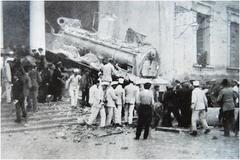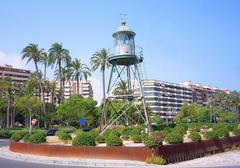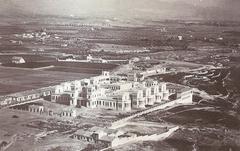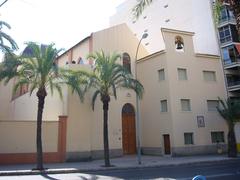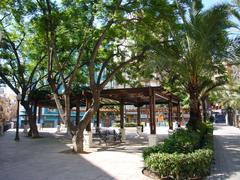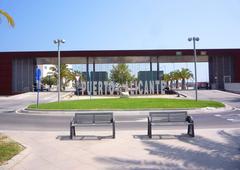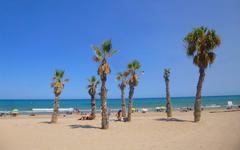
Estació De La Marina Visiting Hours, Tickets, and Alicante Historical Sites Guide
Date: 04/07/2025
Introduction
Estació De La Marina in Alicante, Spain, is a multifaceted destination that beautifully integrates maritime tradition, modern transportation infrastructure, and sustainable urban development. This area encompasses both the historic Marina Deportiva de Alicante and a vital tram station, providing a gateway to Alicante’s beaches, cultural landmarks, and vibrant city life. With roots tracing back to Alicante’s prominence as a Mediterranean port, Estació De La Marina has evolved from a commercial hub to a contemporary center for leisure, tourism, and international sailing events—including hosting the Volvo Ocean Race (Alicante History; Marina Alicante).
The adjoining tram station is a key part of Alicante’s commitment to sustainable mobility, operating on renewable energy and connecting seamlessly with buses and cycling networks. As such, Estació De La Marina stands as an essential stop for anyone eager to experience Alicante’s rich maritime heritage, urban dynamism, and eco-friendly initiatives (TRAM Alicante; Alicante Turismo).
This guide presents everything you need to know for visiting: from hours and ticketing to accessibility, nearby attractions, and sustainable travel practices. Whether you are a leisure traveler, a maritime history enthusiast, or a commuter, Estació De La Marina exemplifies the vibrant Mediterranean spirit of Alicante.
Table of Contents
- Historical Overview
- Transformation into a Modern Marina
- Economic and Social Significance
- Architectural and Transport Integration
- Visiting Hours, Tickets, and Accessibility
- Nearby Attractions and Unique Features
- Frequently Asked Questions
- Urban Integration and Sustainable Development
- Visitor Experience and Practical Tips
- Conclusion
1. Historical Overview
Alicante’s strategic location on the Mediterranean made it an important port from ancient times, with its influence growing through the Middle Ages as a trading hub (Alicante History). Defensive sites like Castillo de Santa Bárbara protected the coastline and the burgeoning port. As Alicante prospered in the 18th and 19th centuries, exports of wine, almonds, and olive oil drove the expansion of port facilities. The transformation into a marina for leisure and recreation began alongside these commercial developments, mirroring trends seen across European coastal cities (Marina Alicante).
2. Transformation into a Modern Marina
In the late 20th century, the port area was reimagined to cater to the growing tourism industry of the Costa Blanca. The Marina Deportiva de Alicante was developed as a modern, dedicated space for nautical activities, tourism, and leisure. Facilities were built to accommodate both local and international visitors, including navigational aids, berthing for over 700 vessels, and distinctive lighthouse markers for safe harbor access (Marina Alicante Access).
3. Economic and Social Significance
Estació De La Marina plays a central role in Alicante’s economy and community life. Its marina is a hub for entertainment, dining, shopping, and nightlife, featuring restaurants, cafés, pubs, shops, and a casino—all within the port area (Marina Alicante Services). Culturally, it is the starting point of prestigious events like the Volvo Ocean Race, attracting international attention (Marina Alicante Events).
4. Architectural and Transport Integration
The marina’s architecture combines modernist lines with open spaces, maximizing sea views and visitor comfort. Its central location at Muelle 8, Zona de Levante, places it within easy reach of Alicante’s main railway station, airport, and major roadways (Marina Alicante Contact). The adjacent tram station, launched in 2003, connects the city center to coastal areas and supports multimodal travel with links to buses, bicycle lanes, and the airport (TRAM Alicante; Alicante Turismo).
5. Visiting Hours, Tickets, and Accessibility
- Marina: Open to the public year-round, 24/7, with no entrance fee. Most commercial venues operate typically from 10:00 AM to midnight. Tickets may be required for special events.
- Tram Station: Operates in line with the TRAM d’Alacant schedule, generally from 5:00 AM to midnight (Metro Map).
- Tickets: Purchase tram tickets at station vending machines or via the official TRAM Alicante app. Pricing depends on travel zones.
- Accessibility: Both marina and station offer step-free access, ramps, elevators, tactile paving, and clear signage.
6. Nearby Attractions and Unique Features
- Explanada de España: Iconic palm-lined promenade with wave-patterned tiles.
- Playa del Postiguet: Central sandy beach, ideal for swimming and sunbathing.
- Santa Bárbara Castle: Historic fortress atop Mount Benacantil with panoramic city views.
- Volvo Ocean Race Museum: Interactive exhibits on ocean racing.
- Casino Mediterráneo Alicante: Gaming tables, live shows, and waterfront dining.
- Mercado Central: Lively market for fresh local produce and regional delicacies.
- Contemporary Art Museum (MACA): Works by Picasso, Dalí, and Miró in the historic old town.
- Tabarca Island: Marine reserve accessible by boat from the marina, ideal for snorkeling.
7. Frequently Asked Questions (FAQ)
Q: What are the main visiting hours?
A: The marina is open 24/7 for public access; tram station operates generally from 5:00 AM to midnight. Individual venues may have seasonal hours.
Q: Are tickets required?
A: No ticket is needed for general marina access. Tram tickets are required for travel and are available at the station or via the TRAM Alicante app.
Q: Is the area accessible?
A: Yes, facilities are designed for full accessibility, including wheelchair access.
Q: How do I reach the marina and station from the airport?
A: Take the C6 airport bus to the central bus station, then walk or connect via tram or bus.
Q: Are guided tours available?
A: Seasonal guided tours are offered through Alicante’s tourism office (Alicante Turismo).
8. Urban Integration and Sustainable Development
Estació De La Marina is a model for sustainable urban mobility. The tram system operates with renewable energy, and the city continues to invest in cycle lanes, hybrid buses, and eco-friendly infrastructure upgrades (Sustainable Alicante). The marina supports community gardens, smoke-free beaches, and educational programs on biodiversity. Ongoing developments focus on improving accessibility, flood management, and green urban spaces (La Marina Infrastructure Projects).
9. Visitor Experience and Practical Tips
Atmosphere:
Enjoy a cosmopolitan yet relaxed waterfront ambiance, especially at sunset.
Dining:
Sample local specialties like arroz a banda and turrón, paired with regional wines.
Events:
Don’t miss the Hogueras de San Juan festival in June or the Volvo Ocean Race departures.
Tips:
- Visit early morning or late afternoon for cooler temperatures.
- Advance booking is recommended for restaurants and special events.
- Use public transport and cycle lanes for eco-friendly travel.
- Respect local customs; tipping 5–10% is customary in restaurants.
10. Conclusion
Estació De La Marina exemplifies Alicante’s blend of maritime tradition, modern convenience, and sustainable urban planning. Whether you’re strolling the palm-lined promenades, enjoying world-class sailing events, or exploring nearby historical sites, the marina offers a rich and accessible experience for all visitors. The adjoining tram station enhances connectivity, supporting both tourism and local life with efficient, environmentally-friendly transport.
For real-time schedules, ticketing, and updates, download the Audiala app or visit the official Alicante tourism website. Make the most of your visit by exploring related articles, joining local events, and embracing sustainable travel practices in Alicante.
References and Further Reading
- Alicante History
- Marina Alicante
- Alicante Travel Guide
- TRAM Alicante
- Alicante Turismo
- Metro Map
- Wikipedia - Estación de La Marina (TRAM Alicante)
- What Alicante: Practical City Transport Tram
- Alicante Turismo - Public Transport
- La Marina Area History
- The Olive Press - La Marina Urbanisation
- Alicante Events





